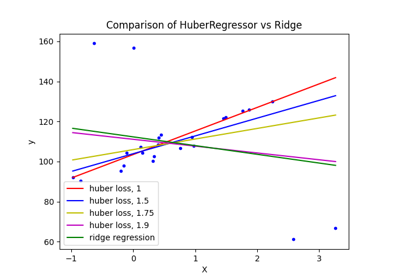HuberRegressor#
- class sklearn.linear_model.HuberRegressor(*, epsilon=1.35, max_iter=100, alpha=0.0001, warm_start=False, fit_intercept=True, tol=1e-05)#
L2-正则化的线性回归模型,对异常值具有鲁棒性。
Huber回归器优化了样本的平方损失,其中
|(y - Xw - c) / sigma| < epsilon,并对样本的绝对损失进行优化,其中|(y - Xw - c) / sigma| > epsilon,其中模型系数w、截距c和尺度sigma是需要优化的参数。参数sigma确保如果y按某个因子放大或缩小,不需要重新调整epsilon以达到相同的鲁棒性。请注意,这并不考虑X的不同特征可能具有不同尺度的事实。Huber损失函数的优点是不受异常值的严重影响,但也不完全忽略它们的影响。
更多信息请参阅 用户指南
Added in version 0.18.
- Parameters:
- epsilonfloat, default=1.35
参数epsilon控制应被分类为异常值的样本数量。epsilon越小,对异常值的鲁棒性越强。epsilon必须在范围
[1, inf)内。- max_iterint, default=100
scipy.optimize.minimize(method="L-BFGS-B")应运行的最大迭代次数。- alphafloat, default=0.0001
平方L2正则化的强度。请注意,惩罚等于
alpha * ||w||^2。 必须在范围[0, inf)内。- warm_startbool, default=False
如果需要重用先前使用的模型的存储属性,这很有用。如果设置为False,则每次调用fit时都会重写系数。 请参阅 术语表 。
- fit_interceptbool, default=True
是否拟合截距。如果数据已经围绕原点居中,可以设置为False。
- tolfloat, default=1e-05
当
max{|proj g_i | i = 1, ..., n}<=tol时,迭代将停止,其中pg_i是投影梯度的第i个分量。
- Attributes:
- coef_array, shape (n_features,)
通过优化L2-正则化Huber损失得到的特征。
- intercept_float
偏置。
- scale_float
|y - Xw - c|被缩小的值。- n_features_in_int
在 fit 期间看到的特征数量。
Added in version 0.24.
- feature_names_in_ndarray of shape (
n_features_in_,) 在 fit 期间看到的特征名称。仅当
X的特征名称均为字符串时定义。Added in version 1.0.
- n_iter_int
scipy.optimize.minimize(method="L-BFGS-B")运行的迭代次数。Changed in version 0.20: 在SciPy <= 1.0.0中,lbfgs迭代次数可能超过
max_iter。n_iter_现在最多报告max_iter。- outliers_array, shape (n_samples,)
一个布尔掩码,其中样本被识别为异常值时设置为True。
See also
RANSACRegressorRANSAC(随机抽样一致性)算法。
TheilSenRegressorTheil-Sen估计器鲁棒多元回归模型。
SGDRegressor通过最小化带SGD的正则化经验损失进行拟合。
References
[1]Peter J. Huber, Elvezio M. Ronchetti, Robust Statistics Concomitant scale estimates, pg 172
[2]Art B. Owen (2006), A robust hybrid of lasso and ridge regression. https://statweb.stanford.edu/~owen/reports/hhu.pdf
Examples
>>> import numpy as np >>> from sklearn.linear_model import HuberRegressor, LinearRegression >>> from sklearn.datasets import make_regression >>> rng = np.random.RandomState(0) >>> X, y, coef = make_regression( ... n_samples=200, n_features=2, noise=4.0, coef=True, random_state=0) >>> X[:4] = rng.uniform(10, 20, (4, 2)) >>> y[:4] = rng.uniform(10, 20, 4) >>> huber = HuberRegressor().fit(X, y) >>> huber.score(X, y) -7.284... >>> huber.predict(X[:1,]) array([806.7200...]) >>> linear = LinearRegression().fit(X, y) >>> print("True coefficients:", coef) True coefficients: [20.4923... 34.1698...] >>> print("Huber coefficients:", huber.coef_) Huber coefficients: [17.7906... 31.0106...] >>> print("Linear Regression coefficients:", linear.coef_) Linear Regression coefficients: [-1.9221... 7.0226...]
- fit(X, y, sample_weight=None)#
拟合模型根据给定的训练数据。
- Parameters:
- Xarray-like, shape (n_samples, n_features)
训练向量,其中
n_samples是样本数量,n_features是特征数量。- yarray-like, shape (n_samples,)
相对于 X 的目标向量。
- sample_weightarray-like, shape (n_samples,)
赋予每个样本的权重。
- Returns:
- selfobject
拟合的
HuberRegressor估计器。
- get_metadata_routing()#
获取此对象的元数据路由。
请查看 用户指南 以了解路由机制的工作原理。
- Returns:
- routingMetadataRequest
MetadataRequest封装的 路由信息。
- get_params(deep=True)#
获取此估计器的参数。
- Parameters:
- deepbool, 默认=True
如果为True,将返回此估计器和包含的子对象(也是估计器)的参数。
- Returns:
- paramsdict
参数名称映射到它们的值。
- predict(X)#
使用线性模型进行预测。
- Parameters:
- Xarray-like 或 sparse matrix, shape (n_samples, n_features)
样本。
- Returns:
- Carray, shape (n_samples,)
返回预测值。
- score(X, y, sample_weight=None)#
返回预测的决定系数。
决定系数 \(R^2\) 定义为 \((1 - rac{u}{v})\) ,其中 \(u\) 是残差平方和
((y_true - y_pred)** 2).sum(),而 \(v\) 是总平方和((y_true - y_true.mean()) ** 2).sum()。最好的可能得分是 1.0,它可能是负的(因为模型可能任意地差)。一个总是预测y的期望值的常数模型,忽略输入特征,将得到 \(R^2\) 得分为 0.0。- Parameters:
- Xarray-like of shape (n_samples, n_features)
测试样本。对于某些估计器,这可能是一个预计算的核矩阵或一个形状为
(n_samples, n_samples_fitted)的通用对象列表,其中n_samples_fitted是估计器拟合中使用的样本数量。- yarray-like of shape (n_samples,) or (n_samples, n_outputs)
X的真实值。- sample_weightarray-like of shape (n_samples,), default=None
样本权重。
- Returns:
- scorefloat
\(R^2\) 相对于
y的self.predict(X)。
Notes
在调用回归器的
score时使用的 \(R^2\) 得分从 0.23 版本开始使用multioutput='uniform_average'以保持与r2_score默认值一致。 这影响了所有多输出回归器的score方法(除了MultiOutputRegressor)。
- set_fit_request(*, sample_weight: bool | None | str = '$UNCHANGED$') HuberRegressor#
Request metadata passed to the
fitmethod.Note that this method is only relevant if
enable_metadata_routing=True(seesklearn.set_config). Please see User Guide on how the routing mechanism works.The options for each parameter are:
True: metadata is requested, and passed tofitif provided. The request is ignored if metadata is not provided.False: metadata is not requested and the meta-estimator will not pass it tofit.None: metadata is not requested, and the meta-estimator will raise an error if the user provides it.str: metadata should be passed to the meta-estimator with this given alias instead of the original name.
The default (
sklearn.utils.metadata_routing.UNCHANGED) retains the existing request. This allows you to change the request for some parameters and not others.Added in version 1.3.
Note
This method is only relevant if this estimator is used as a sub-estimator of a meta-estimator, e.g. used inside a
Pipeline. Otherwise it has no effect.- Parameters:
- sample_weightstr, True, False, or None, default=sklearn.utils.metadata_routing.UNCHANGED
Metadata routing for
sample_weightparameter infit.
- Returns:
- selfobject
The updated object.
- set_params(**params)#
设置此估计器的参数。
该方法适用于简单估计器以及嵌套对象(例如
Pipeline)。后者具有形式为<component>__<parameter>的参数,以便可以更新嵌套对象的每个组件。- Parameters:
- **paramsdict
估计器参数。
- Returns:
- selfestimator instance
估计器实例。
- set_score_request(*, sample_weight: bool | None | str = '$UNCHANGED$') HuberRegressor#
Request metadata passed to the
scoremethod.Note that this method is only relevant if
enable_metadata_routing=True(seesklearn.set_config). Please see User Guide on how the routing mechanism works.The options for each parameter are:
True: metadata is requested, and passed toscoreif provided. The request is ignored if metadata is not provided.False: metadata is not requested and the meta-estimator will not pass it toscore.None: metadata is not requested, and the meta-estimator will raise an error if the user provides it.str: metadata should be passed to the meta-estimator with this given alias instead of the original name.
The default (
sklearn.utils.metadata_routing.UNCHANGED) retains the existing request. This allows you to change the request for some parameters and not others.Added in version 1.3.
Note
This method is only relevant if this estimator is used as a sub-estimator of a meta-estimator, e.g. used inside a
Pipeline. Otherwise it has no effect.- Parameters:
- sample_weightstr, True, False, or None, default=sklearn.utils.metadata_routing.UNCHANGED
Metadata routing for
sample_weightparameter inscore.
- Returns:
- selfobject
The updated object.




